Difference between revisions of "3: Questions for Viewers"
From OutHistory
Jump to navigationJump to searchMarkDilley (talk | contribs) (move header to the right?) |
m (Protected "3: Questions for Viewers" ([edit=sysop] (indefinite) [move=sysop] (indefinite)) [cascading]) |
||
| (11 intermediate revisions by the same user not shown) | |||
| Line 1: | Line 1: | ||
| − | + | '''Continued from:''' [[2: The Man-Monster Lithograph]] | |
=Ten Questions for Viewers of The Man-Monster Exhibit= | =Ten Questions for Viewers of The Man-Monster Exhibit= | ||
| − | : The goal of these questions is to help viewers locate the Man-Monster print in context of its time. | + | :The goal of these questions is to help viewers locate the Man-Monster print in context of its time. Please leave your responses in the Comment box at the bottom of the page. |
| − | |||
| − | ===(1) How does the Man Monster print visually characterize a black woman?=== | + | ===(1) How does the Man-Monster print visually characterize a black woman?=== |
| − | + | :See: [[2: The Man-Monster Lithograph]] | |
| − | + | ||
| − | + | ||
| − | + | ===(2) Does the characterization "Man-Monster" contradict the visualization of Sewally/Jones in the print?=== | |
| + | :See: [[2: The Man-Monster Lithograph]] | ||
| − | |||
| − | |||
| − | |||
| − | |||
| − | |||
===(3) How does this print's representation of a black woman compare with other images of black women in American popular culture of the 19th century?=== | ===(3) How does this print's representation of a black woman compare with other images of black women in American popular culture of the 19th century?=== | ||
| − | : Consider images from print culture, sentimental fiction, and the minstrel stage | + | : Consider images from print culture, sentimental fiction, and the minstrel stage. Here are some examples: |
| − | : [ | + | Below: From E.W. Clay, ''Life in Philadelphia," 1829. |
| + | [[File:Clay image008.png|575px]] | ||
| − | |||
| − | : | + | Below: From E.W. Clay, "Life in Philadelphia, No. 11," 1828. |
| − | + | [[File:Raster-1.jpeg|575px]] | |
| − | |||
| − | |||
| − | |||
| − | |||
| − | |||
| − | |||
| − | |||
| − | |||
| − | ===(5) What might a buyer of | + | Below: From E.W. Clay, "Life in Philadelphia," No. 12, 1829. |
| − | + | [[File:Raster-2.jpeg|575px]] | |
| − | + | ||
| − | + | ||
| − | + | Below:"Life in Philadelphia" [unnumbered], 1828. | |
| + | [[File:Raster.jpeg|575px]] | ||
| + | |||
| + | |||
| + | Below: Minstrel show performers Rollin Howard (in wench costume) and George Griffin, c. 1855. | ||
| + | [[File:Howard.Griffin.MED.MED.jpg]] | ||
| + | |||
| + | |||
| + | ===(4) How expensive was the Man-Monster lithograph, and what class of people would be expected to buy it?=== | ||
| + | :The same firm that published the Man-Monster print the same year published a print illustrating the murdered prostitute Helen Jewett. A scholarly study of that 1836 murder says: "mass produced lithographs made Jewett's image available to anyone for a modest price." | ||
| + | |||
| + | |||
| + | ===(5) What might a buyer of the Man-Monster print like about it?=== | ||
| + | :See: [[2: The Man-Monster Lithograph]] | ||
| + | |||
| + | |||
| + | ===(6) What does the history of the Man-Monster print's maker and publisher tell us about the character of his print?=== | ||
| + | :See: [[2: The Man-Monster Lithograph]] | ||
| − | |||
| − | |||
| − | |||
| − | |||
| − | |||
===(7) How might we think about the Man-Monster print in relation to the sexually suggestive Helen Jewett print produced by the same printer?=== | ===(7) How might we think about the Man-Monster print in relation to the sexually suggestive Helen Jewett print produced by the same printer?=== | ||
| − | : | + | :See [[2: The Man-Monster Lithograph]]. By the way, none of this printer's explicitly pornographic prints are known to exist. |
| − | + | ||
| − | |||
| − | |||
| − | |||
===(8) How might the Man-Monster print relate to 19th century men’s interest in and anxiety about independent women, female sex workers, and sapphic desire?=== | ===(8) How might the Man-Monster print relate to 19th century men’s interest in and anxiety about independent women, female sex workers, and sapphic desire?=== | ||
| − | <br /> | + | <br/> |
| − | <br /> | + | <br/> |
| − | + | ===(9) Does the Man-Monster image provide insight into the history of transgendered bodies and identities?=== | |
| − | + | <br/> | |
| − | + | <br/> | |
| − | ===(9) Does | ||
| − | <br /> | ||
| − | <br /> | ||
| − | |||
| − | |||
| − | |||
===(10) Can you think of other questions that can help us understand this image in its original historical context?=== | ===(10) Can you think of other questions that can help us understand this image in its original historical context?=== | ||
| − | : If so, we'd all love to hear them. Please leave your answers, thoughts, and comments in the Comment box | + | : If so, we'd all love to hear them. Please leave your answers, thoughts, and comments in the Comment box below. |
| − | <br /> | + | <br/> |
| − | <br /> | + | <br/> |
| − | |||
| − | |||
| − | |||
=Next: [[4: The Man-Monster's Legacy]]= | =Next: [[4: The Man-Monster's Legacy]]= | ||
| − | + | Sources: [[More Information About Sewally and the Man-Monster Print]] | |
| − | |||
__NOTOC__ | __NOTOC__ | ||
__NoEditSection__ | __NoEditSection__ | ||
Latest revision as of 06:48, 23 July 2011
Continued from: 2: The Man-Monster Lithograph
Ten Questions for Viewers of The Man-Monster Exhibit
- The goal of these questions is to help viewers locate the Man-Monster print in context of its time. Please leave your responses in the Comment box at the bottom of the page.
(1) How does the Man-Monster print visually characterize a black woman?
(2) Does the characterization "Man-Monster" contradict the visualization of Sewally/Jones in the print?
(3) How does this print's representation of a black woman compare with other images of black women in American popular culture of the 19th century?
- Consider images from print culture, sentimental fiction, and the minstrel stage. Here are some examples:
Below: From E.W. Clay, Life in Philadelphia," 1829.
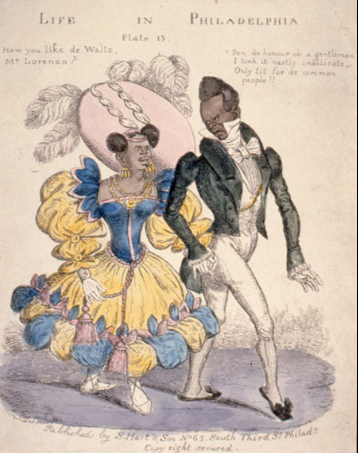
Below: From E.W. Clay, "Life in Philadelphia, No. 11," 1828.
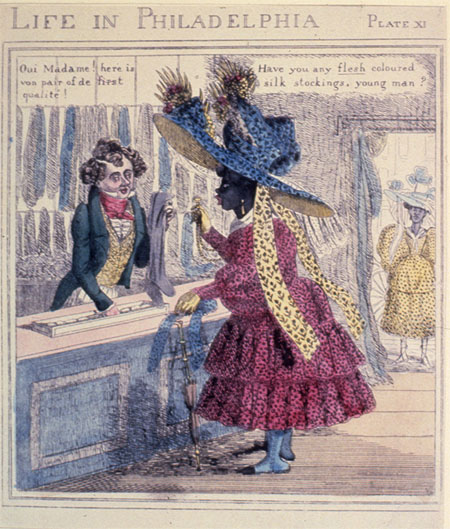
Below: From E.W. Clay, "Life in Philadelphia," No. 12, 1829.
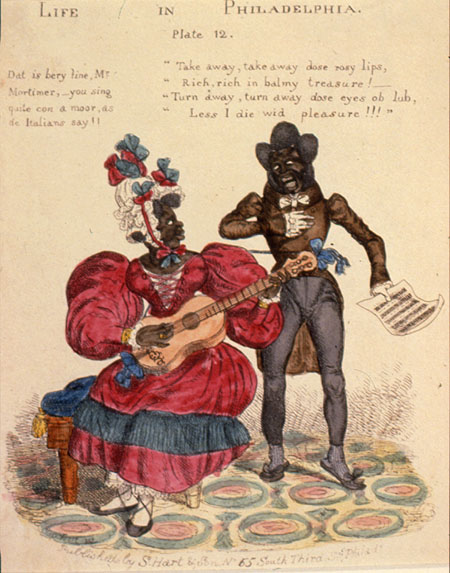
Below:"Life in Philadelphia" [unnumbered], 1828.
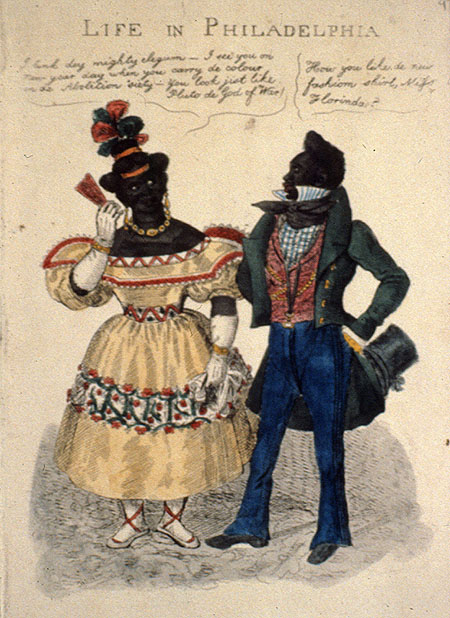
Below: Minstrel show performers Rollin Howard (in wench costume) and George Griffin, c. 1855.
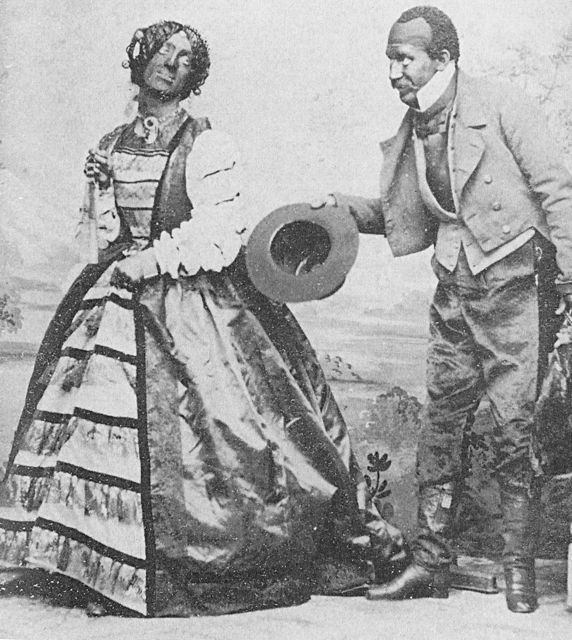
(4) How expensive was the Man-Monster lithograph, and what class of people would be expected to buy it?
- The same firm that published the Man-Monster print the same year published a print illustrating the murdered prostitute Helen Jewett. A scholarly study of that 1836 murder says: "mass produced lithographs made Jewett's image available to anyone for a modest price."
(5) What might a buyer of the Man-Monster print like about it?
(6) What does the history of the Man-Monster print's maker and publisher tell us about the character of his print?
(7) How might we think about the Man-Monster print in relation to the sexually suggestive Helen Jewett print produced by the same printer?
- See 2: The Man-Monster Lithograph. By the way, none of this printer's explicitly pornographic prints are known to exist.
(8) How might the Man-Monster print relate to 19th century men’s interest in and anxiety about independent women, female sex workers, and sapphic desire?
(9) Does the Man-Monster image provide insight into the history of transgendered bodies and identities?
(10) Can you think of other questions that can help us understand this image in its original historical context?
- If so, we'd all love to hear them. Please leave your answers, thoughts, and comments in the Comment box below.
Next: 4: The Man-Monster's Legacy
Sources: More Information About Sewally and the Man-Monster Print